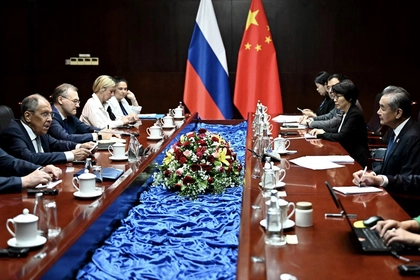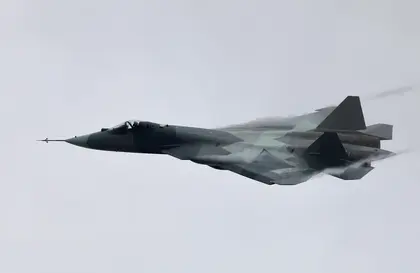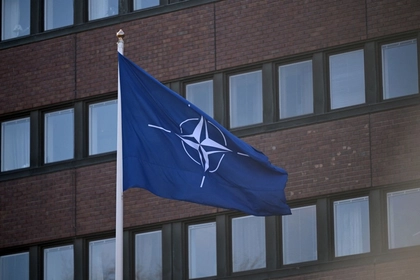Russia’s United Aircraft Corporation (UAC) has registered a new patent for a two-seat stealth fighter that closely resembles its current Su-57 Felon (NATO name) – but it came with a description that extensively referenced a different fighter aircraft altogether – the Su-30MK, a Russian export.
In the patent, the company outlined the technical specifications of the new design as well as the details surrounding its role and capabilities, namely, that it’s an aerial command center capable of launching and/or controlling unmanned aerial vehicles capable of carrying bombs and other combat aircraft.
JOIN US ON TELEGRAM
Follow our coverage of the war on the @Kyivpost_official.
It would “[act] as an airborne command post for network-oriented operations mixed groups of aircraft” according to the patent, using avionics similar to the data link system the US, NATO, Japan, and other allied military forces have been operating with for decades (Tactical Data Link (TDL) – ed.), but purportedly with interoperation capabilities more like the American-made fifth generation F-35.
It also referenced earlier patents of Su-57s, explaining that the new design would be a two-seat version of its stealth fighter, as well as various current US and European two-seat versions of single-seat fighter aircraft.
However, it stated that the closest comparison of the new design would be the Su-30MK – an export version of a Russian fourth-generation two-seater air superiority fighter – as opposed to the new Su-57 fighters, despite sharing the same airframe.

Russia, China FMs Meet as ASEAN Talks Get Underway in Laos
In the description are also the expectations for the aircraft – namely a more modern, flexible, maneuverable, and stealthier version of the Su-30MK; It would fulfill the role of Su-30MK fighters with improved stealth capabilities and avionics.
“The technical result of the claimed invention is to reduce the level of visibility of the aircraft in the radar range [radar signature or radar cross-section (RCS) – ed.], increase the maneuverability of the aircraft up to super-maneuverability, increase the level of aerodynamic characteristics of the aircraft at supersonic and subsonic flight speeds, expand the functionality of the aircraft in terms of info-communication interaction,” reads the patent.
The patent also cited an improved “operational manufacturability,” which is somewhat of an ironic statement considering the troubling development and production of its Su-57 fighters, of which there are only 10 units in service with Russia’s Aerospace Forces.
The logic behind the patent description has also led to different interpretations.
Since it referenced the export model (Su-30MK) specifically, it could be the Kremlin’s attempt to generate hype for potential exports, especially considering the interests of Su-30s among foreign buyers.
A two-seat version of the Su-57 was also originally exclusive to the joint Indian-Russia development program for the Su-57, from which India withdrew in 2018 since the jet did not meet the fifth-generation requirements, predominantly in its avionics capabilities. Russia did originally indicate it planned to operate a two-seat version of the Su-57.
Another item of note is that prior to Putin’s announcement to purchase 76 units of Su-57s, analysts have speculated that Russia would instead focus on modernizing existing Su-30s as a more economical solution, which might explain the rationale behind the patent using Su-30MK to state its argument.
Traditionally, a two-seat fighter of the third (e.g., F-4) and fourth (e.g., F-15E) generations would delegate the role of weapon and radio operations to the rear pilot and leave the flying to the pilot at the front. This could be essential in scenarios such as laser-guided bomb employment or ground mapping radar weapons deliveries, which require the operator to focus on the target while controlling the aircraft – increasing the danger of flying into terrain during low-altitude target attacks.
However, US fifth-generation stealth fighters and most generation fighters have negated the need for weapons systems operators with the use of advanced avionics, where the computer would handle the task instead.
The patent also says the rear cockpit would be missionized for the rear-cockpit pilot/crewmember to function as an “air command post” to direct other aircraft, both piloted and uncrewed drones.
The patent translates: “The specialized command and information field of the rear cockpit, in comparison with the front cockpit, has the following differences: an extended panoramic situational display and an additional display to increase the operator’s working field of regard area; sets of controls to transfer the control priority from one cockpit to the other, and also excludes controls that do not require the control of a second crew member, which makes it possible to quickly receive information from various external sources (aviation, land, and sea), analyze it on board the aircraft and issue recommendations or a command to perform a combat mission to the aircraft of the group, taking into account their fuel and combat equipment.”
As stated in the patent, Russia’s proposed two-seater would also permit flight control transfer from one pilot to another, like other existing two-seat fighter aircraft, but with unspecified differences in control abilities. This would likely prioritize the command post controls over the rear seat abilities to perform all tasks available to the front-seat pilot.
In addition to referencing the Su-30MK, the patent made comparisons with various Western two-seat fighters, including the F-15D (two-seat version of the F-15C) and F/A-18F (two-seat version of the F/A-18E), that have essentially duplicate front and rear cockpits but made no mention of the F-15E or F/A-18D, both of which have missionized cockpits with the F/A-18D rear-seat occupant having no ability to fly the aircraft.
There has been no visual confirmation of Russia’s use of Su-57s in Ukraine, but both Ukrainian and British sources believe that Russia likely deployed the stealth fighters against Ukrainian targets from its own airspace in fear of losing them over Ukrainian air defenses.
With the international sanctions imposed on the Russian aerospace industry following the Kremlin’s full-scale invasion of Ukraine, which prompted China to drop Russia from its new intercontinental C-292 project, and Russia’s inability to satisfy its own internal military and aviation needs, the new two-seat Su-57 is probably an overly optimistic and ambitious project that may never get off the ground.
You can also highlight the text and press Ctrl + Enter






